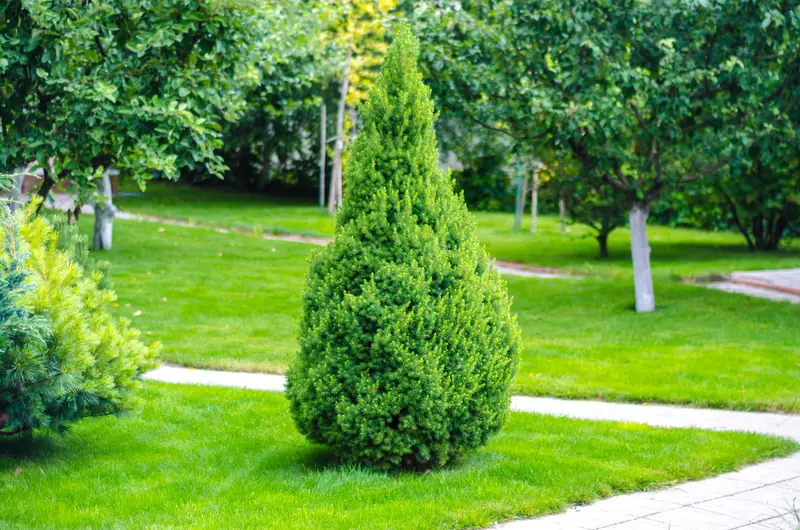But, yellowing at any other times hints that your arborvitae is suffering from some treatable conditions. However, since they are treatable, still, there is nothing to worry about. In this article, we are going to talk about why your arborvitae turning yellow and how to get rid of it.
Let’s dive in!

What Causes Arborvitae Turning Yellow?
Yellow foliage on arborvitae plants generally indicates a cultural problem or disease/pest that you should take care of to aid your plant in return to good health.
The most common causes of happening so are:
- Cypress tip miner
- Scale damage
- Leaf scorch
- Nutrient deficiency
- Seasonal problems
How To Get Rid of Yellow Arborvitae?
In this section, we are going to talk about the problems in detail and provide effective solutions to them.
Cypress Tip Miner
Cypress tip miner is a silvery moth that gardeners are well known with. These moths are grayish-brown colored and they deposit their eggs on green leaves. The larvae of cypress tip miner chew inside the foliage and small twigs that cause foliage to turn yellow in early winter.
Over time, these yellow foliages will turn brown and eventually die. The foliage turns brown in late winter and early spring. However, the green color of foliage will be restored by a new green color in the spring and summer. So, it will not necessarily kill the plants. But when the plants growing in a nursery, the discolored plants become unmarketable.
Solution: To check tip miners, shake the branches in early spring and see whether moths fly out of the brunches. Then, remove and destroy infected branches. After that, spray the established arborvitae using acephate-based insecticides, it will minimize the discoloration when the moths emerge from cocoons (between March and May). Also, water regularly, it will help the plants to keep them vigorous.
Scale Damage
For sale damage of arborvitae plants, juniper, and minute cypress scale damage insects are responsible. The circular to oval, wingless, white, or pale-gray insects are easy to recognize.
The insects weaken a plant by colonizing the needles’ undersides and cause yellowing and branch dieback. Generally, the infested plants appeared water-stressed, leave start yellowing, and drop prematurely. Moreover, the plants that become heavily infested may die.
The main intention of attacking arborvitae plants of these insects is to feed on foliage sap. Also, the larvae or crawlers feed throughout the summer. They evolve a hard, protective coating and overwinter in place to mate as well as feed the following year.
Solution: For saving your plants from both of the pests, prune the heavily populated branches and spray the plants with horticultural oil during their winter dormancy. Also, provide your plants with proper culture care (especially, appropriate irrigation) to make them more resistant to scale damage.
Leaf Scorch
Leaf scorch is not an infectious but physiological condition caused by hot and dry summer conditions. This condition typically arrives in July and August as a yellowing between the leaf veins and the leaf margins.
The leaf parts are the last to get water supply from the roots, they get affected at first. Scorched leaves are usually most exposed to prevailing strong sunlight and wind. The entire plant may not be uniformly affected but leaves on the same branch sometimes show similar symptoms.
Solution: While dry weather conditions are going on over a long period of time, you should water the plants deeply every 10-15 days. Besides, the newly transplanted plants should get water every 7-10 days.
In early spring or late fall, apply fertilizers to minimize the potential injury. Besides, prune any dead or diseased branches.
Nutrient Deficiency
If there is a soil deficient in nitrogen, iron, potassium, manganese, or zinc then chlorotic needles on arborvitae may occur. Nitrogen deficiency on arborvitae causes producing yellow, short, and tightly clumped needles. Eventually, newly planted plants fail to grow side branches.
Potassium deficiency causes the plants to become deep-blueish green before paling to yellow and reddish-brown. Manganese and iron deficiencies cause chlorosis of the newer needles and the upper crowns.
Solution: The bad news is diagnosing the nutrient deficiency from symptoms are very difficult. Iron deficiency occurs in soil that contain high pH (above 7). To prevent it, apply elemental sulfur combined with ferrous sulphate. Apply nitrogen-based fertilizer to fill up the nitrogen deficiency and potassium-based fertilizers to prevent potassium deficiency.
Seasonal Problems
Yellowing leaves during a growing season indicates an effect of environmental stress. It can be happened for chilly weather or very windy conditions. However, most of the change of leaves color and leaves drop occur during water stress in both drought and flooded conditions. Moreover, transplanting a shrub may also cause stress symptoms.
Solution: It may seem impractical to cover the tree with barriers (e.g burlap or plastic). But watering right before the ground freezes will help preventing winter dehydration.
Frequently Asked Questions
Question: Is overwatering responsible for foliage discoloration?
Answer: Yes, it is responsible. If there is no rain immediately after planting, let a hose drip for 24 hours. Repeat deep soaking at least twice a week.
Question: What is the best fertilizer for arborvitae?
Answer: Using slow-release fertilizer that contains 50% nitrogen will be the best choice.
Conclusion
We are at the dead end. Hopefully, you got every single answer to why your arborvitae turning yellow and how you can solve this problem.
Try to water properly and let your plants getting proper sunlight. If you are careful about the maintenance from the very first days, you will suffer less in the future.
Wish you good luck!
